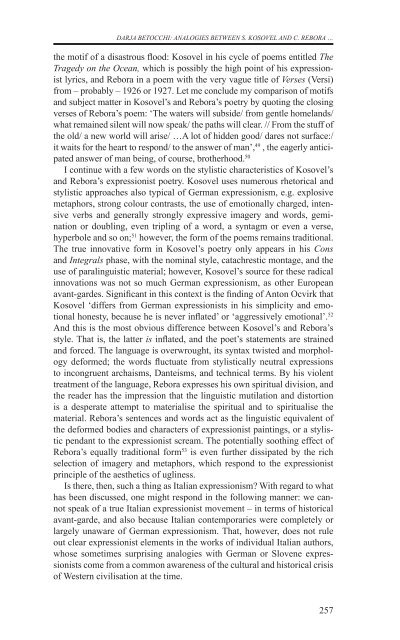razprave (pdf) - Društvo za primerjalno književnost - ZRC SAZU
razprave (pdf) - Društvo za primerjalno književnost - ZRC SAZU
razprave (pdf) - Društvo za primerjalno književnost - ZRC SAZU
- No tags were found...
Create successful ePaper yourself
Turn your PDF publications into a flip-book with our unique Google optimized e-Paper software.
Darja Betocchi: Analogies between S. Kosovel and C. Rebora …the motif of a disastrous flood: Kosovel in his cycle of poems entitled TheTragedy on the Ocean, which is possibly the high point of his expressionistlyrics, and Rebora in a poem with the very vague title of Verses (Versi)from – probably – 1926 or 1927. Let me conclude my comparison of motifsand subject matter in Kosovel’s and Rebora’s poetry by quoting the closingverses of Rebora’s poem: ‘The waters will subside/ from gentle homelands/what remained silent will now speak/ the paths will clear. // From the stuff ofthe old/ a new world will arise/ …A lot of hidden good/ dares not surface:/it waits for the heart to respond/ to the answer of man’, 49 , the eagerly anticipatedanswer of man being, of course, brotherhood. 50I continue with a few words on the stylistic characteristics of Kosovel’sand Rebora’s expressionist poetry. Kosovel uses numerous rhetorical andstylistic approaches also typical of German expressionism, e.g. explosivemetaphors, strong colour contrasts, the use of emotionally charged, intensiveverbs and generally strongly expressive imagery and words, geminationor doubling, even tripling of a word, a syntagm or even a verse,hyperbole and so on; 51 however, the form of the poems remains traditional.The true innovative form in Kosovel’s poetry only appears in his Consand Integrals phase, with the nominal style, catachrestic montage, and theuse of paralinguistic material; however, Kosovel’s source for these radicalinnovations was not so much German expressionism, as other Europeanavant-gardes. Significant in this context is the finding of Anton Ocvirk thatKosovel ‘differs from German expressionists in his simplicity and emotionalhonesty, because he is never inflated’ or ‘aggressively emotional’. 52And this is the most obvious difference between Kosovel’s and Rebora’sstyle. That is, the latter is inflated, and the poet’s statements are strainedand forced. The language is overwrought, its syntax twisted and morphologydeformed; the words fluctuate from stylistically neutral expressionsto incongruent archaisms, Danteisms, and technical terms. By his violenttreatment of the language, Rebora expresses his own spiritual division, andthe reader has the impression that the linguistic mutilation and distortionis a desperate attempt to materialise the spiritual and to spiritualise thematerial. Rebora’s sentences and words act as the linguistic equivalent ofthe deformed bodies and characters of expressionist paintings, or a stylisticpendant to the expressionist scream. The potentially soothing effect ofRebora’s equally traditional form 53 is even further dissipated by the richselection of imagery and metaphors, which respond to the expressionistprinciple of the aesthetics of ugliness.Is there, then, such a thing as Italian expressionism? With regard to whathas been discussed, one might respond in the following manner: we cannotspeak of a true Italian expressionist movement – in terms of historicalavant-garde, and also because Italian contemporaries were completely orlargely unaware of German expressionism. That, however, does not ruleout clear expressionist elements in the works of individual Italian authors,whose sometimes surprising analogies with German or Slovene expressionistscome from a common awareness of the cultural and historical crisisof Western civilisation at the time.257
















